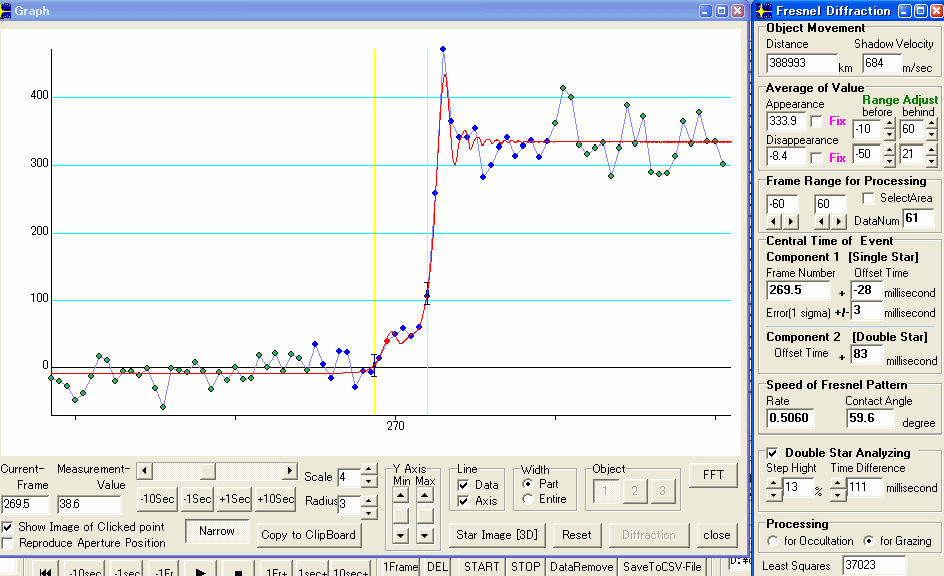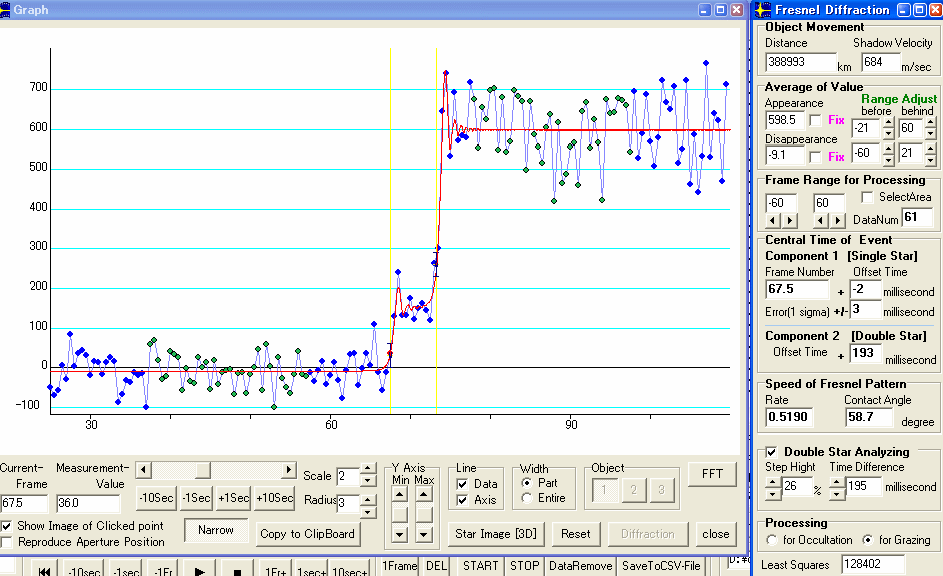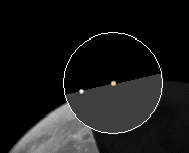
Analyzing double star SAO118571 (XZ16391) which has suspected variable star component
Kazuhisa Miyashita
Dec.08 2007
1. Introduction
SAO118571 is known as a double star which has a component as a suspected variable star. Table 1 shows the prediction by OCCULT 4.0. It is described that SAO118571 is variable from 8.9 mag to 9.27 mag. Masayuki Ishida kindly sent me a .avi video file observed occultation of this double star. The video file is analyzed using diffraction fitting feature of Limovie. As a result, the magnitude of component at the event time obtained as 9.60 mag.
|
Table 1. Result of analysis |
||
|
|
Observation |
Catalog |
|
Separation (arcsec) |
0.035 |
0.034 |
|
Position Angle (degree) |
39 |
104.5 |
|
If the magnitude of the pair is 7.38 then .. |
||
|
First star(mag) |
7.62 +/-0.12 |
8.0 |
|
Second star(mag) |
9.22 +/-0.53 |
8.8 |
2.Prediction of occultation event
by OCCULT 4.0
|
Occultation prediction for Ishida Konohama E. Longitude 135 56 33.6, Latitude 35 6 22.3, Alt. 86m; Telescope dia100cm; dMag 0.0 day Time P Star Sp Mag Mag % Elon Sun Moon CA PA VA AA Libration A B RV Cct R.A. (J2000) Dec y m d h m s No D v r V ill Alt Alt Az o o o o L B m/o m/o "/sec o h m s o m s 07 Dec 1 19 35 12 R 118571cK0 7.4 7.0s 47- 86 54 138 24N 358 32 337 +7.5 +1.5 +0.2-3.5 .238 131 10 54 45.6 5 50 52 118571 is double: 8.0 8.8 0.034" 104.5 118571 = NSV 05015, 8.9 to 9.27P, Type E: Occultation prediction for KarasakiNerima E. Longitude 139 40 0.3, Latitude 35 44 25.4, Alt. 46m; Telescope dia100cm; dMag 0.0
day Time P Star Sp Mag Mag % Elon Sun Moon CA PA VA AA Libration A B RV Cct R.A. (J2000) Dec y m d h m s No D v r V ill Alt Alt Az o o o o L B m/o m/o "/sec o h m s o m s 07 Dec 1 19 31 42 R 118571cK0 7.4 7.0s 47- 86 55 142 9N 13 43 352 +7.4 +1.6 -0.8-5.3 .163 117 10 54 45.6 5 50 52 118571 is double: 8.0 8.8 0.034" 104.5 118571 = NSV 05015, 8.9 to 9.27P, Type E:
|
Table 2. Prediction calculated by OCCULT 4.0
from LOW 4.0
Moon distance = 388993
3. Detail of the double star
Component is suspected double star. It is described in ..
from The SKY..
|
Name: NSV5015 Magnitude: 8.9 Object: suspected variable star catalog: NSV (New Suspected Variable Stars) NSV: 05015 |
Type: P E: Max: 8.9 Min: 9.27 period: 5 Spector type: K0 |
Table 3. Detail of suspected variable star NSV05015
4. Diffraction fitting
4-1. Preparation
Lunar velocity = RV*Pi *Dm / (cos(Cct) *3600*180)
= 0.238*3.1415*388993000 / (-cos(131)*3600*180) =684
Dm: moon distance
4-2 Analyzing

Figure 1. Diffraction fitting
The light curve is well fitt to diffraction simulation and the contact angle (59.6) obtained from this fitting is agree the predcted contact angle(59=180-131). It considered that the result of this analysis shows the effectiveness of the fitting.

Figure 2. Diffraction fitting
5. Result
5-1 Event time
Moriyama, Shiga:
The time of field (No.269.5) exposure is
Start: 19h35m12.87s; End: 19h35m12.89s (UTC).
Therefore the frame as a base point is 19h35m12.88s.
Hence the event time is below.
First event (fainter star): 19h35m12.86s (UTC).
Secont event (brighter star): 19h35m12.97s (UTC).
Nerima, Tokyo:
The time of field (No.67.5) exposure is
Start: 19h31m46.24s; End: 19h31m46.26s (UTC).
Therefore the frame as a base point is 19h31m46.25s.
Hence the event time is below.
First event (fainter star): 19h31m46.25s (UTC).
Secont event (brighter star): 19h31m46.44s (UTC).
5-2 Magnitude
Moriyama, Shiga:
Limonous intensity of companion star (NSV05015) is 13% of the main star's. Therefore the difference of magnitude between the pair and fainter star is 2.22mag.
If the magnitude of pair is assumed 7.38 then the main star is 7.58mag and companion star is 9.60 mag.
The time difference of event is 111millisecond (0.111second). Then the separation for the direction to parpendicular to lunar limb is 0.026.
Nerima, Tokyo:
Limonous intensity of companion star (NSV05015) is 26% of the main star's. Therefore the difference of magnitude between the pair and fainter star is 1.46mag.
If the magnitude of pair is assumed 7.38 then the main star is 7.71mag and companion star is 8.84 mag.
The time difference of event is 193millisecond (0.193second). Then the separation for the direction to parpendicular to lunar limb is 0.031.
The intensity of intermidiate step is two times different from each other. It is possible to differ the effect of background noise.
5-3 Astrometry of doublestar
(1) Expected time difference
The expected time difference (T) of this event is given..
Sep*cos(Pc-Po)/RV
Sep: separation of two stars; RV: relational velocity; Pc: position angle of component; Po: position angle of occultation.
Moriyama, Shiga:
T is 0.097 second. It is near the analyzing result 0.111.
Nerima, Tokyo:
T is 0.050 second. It is differ from the analyzing result 0.193.
There is an issue about the event order. If the position angle is 104 degree as catalog description (as shown in figure.3), then the main component should appear at first. However the fainter star appeared at first and main star is later in this observation. It means the value of position angle on the catalog is incorrect (in at least presently situation).


Figure 3. Astrometry of doublestar described in catalog (figured by LOW 4.0)
Left: Moriyama,Shiga; Right: Nerima,Tokyo.
There are different from event order of observation.
(2) Astrometry
Position angle and separation is calculated by the formula described in below page.
Double Star Observation SAO118981(=XZ17514,=ZC1692) in Apr.28 2007
The result of this analysis is ..

6. Conclusion
Main star and companion star have spectrum type as K0. Therefore the magnitude of companion star can be determined from the main star's magnitude.
The variable range of NSV05015 is described from 8.8 to 9.27. The magnitude obtained from this analyzing is 9.22. And the difference of magnitude between two components is 1.60 mag. This is different from the catalog description (0.8 mag.). From this, there is possibility of which the star is the _regular_ variable star.
Position angle obtained from occultation observation differ from catalog largely.